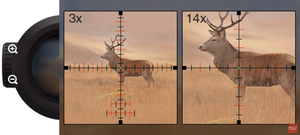Introduction
Ever had one of those range days where you wish you took an extra minute to improve your aim? An extra Minute of Angle, to be more precise. If so, we need to talk about MOA, the ultimate competitive edge for shooters.
You've probably heard about MOA from hunters and sport shooters. While it might sound like a tricky math concept, it's a game-changer for shooting accuracy. Understanding Minute of Angle is essential in long-distance scenarios where you need precise, fine-tuned adjustments.
Minute of Angle is vital for shooting accuracy in competition. By definition, MOA is an angular measurement, meaning it scales with distance. At 200 yards, 1 MOA equals approximately 2 inches; at 300 yards, it equals about 3 inches, and so on.
Wait… exactly what is MOA?
Don't worry, shooter. We’ll break down the math for you. You've hit the target with our MOA explainer guide for beginners, with all the basics and some practice tips for elite sharpshooters. We even have a secret MOA tip for you, so let’s get straight to it.
What is MOA?
Let’s start with the basics: Minute of Angle, or MOA, is a standard for calibrating firearm sights and scopes to ensure accurate shots. Some people mistakenly think that MOA is about measuring distance or even time. But in reality, MOA is all about angles—specifically, the angle your bullet travels in relation to your line of sight.
When we talk about the Minute of Angle, we’re talking about degrees. What do degrees have to do with MOA? Each degree can be broken down into smaller parts called minutes. There are 60 minutes in each degree, just like there are 60 minutes in an hour.
So, when we talk about a Minute of Angle, we're talking about 1/60th of a single degree in that 360-degree circle.
Imagine a top-down view of a shooter with a full circle around them. There you get your 360-degree full view. For safety, we always shoot within a 180-degree perimeter, which is the safe zone in front of us. The MOA standard allows you to calibrate your firearm by dividing each of those degrees into 60 parts, or 60 Minutes of Angle.
This might seem small, but believe us, you can spot the difference between beginners and pros in USPSA competitions by who’s fine-tuning MOA on their handguns.
Now, let’s see how those minutes become crucial in adjusting your aim for accuracy.
How MOA relates to shooting accuracy
Have you noticed that the further you shoot, the more dispersed your hits are on the target? That’s where Minute of Angle comes in to help you fine-tune your accuracy.
What is MOA in practical shooting accuracy terms? As a standard, MOA is 1 inch for every 100 yards. As The Firearm Industry Trade Association says, technically, it’s 1.047 inches, but to keep things simple, most shooters stick to the 1-inch rule.
Let’s illustrate MOA with a straightforward example:
- At 100 yards, 1 MOA equals 1 inch, roughly the size of a quarter.
- Move that target out to 200 yards, and that same 1 MOA now covers approximately 2 inches.
- Push it further to 300 yards, and you're looking at a 3-inch MOA spread.
So, the concept of MOA in firearms is simple: as distance increases, the impact area of your shots gets larger. Adjusting your sights according to MOA helps you compensate for that.
Since this is MOA explained for beginners, let’s get even more practical:
Imagine you have paper targets set up at 100, 200, and 300 yards downrange. When you fire at these targets, your groupings—the cluster of bullet holes—will spread out as the distance increases. That spread you’re witnessing, fellow shooter, is what you can adjust with MOA.
This is why Minute of Angle is critical for shooting accuracy, especially in long-distance shooting. Hunters and sport shooters surely know what we’re talking about. And if you’re a beginner, keep reading, because we’re going to make MOA so easy to understand that it’ll change your range days forever.
Why MOA Matters in Shooting
Apart from being a must for long-distance shooters, understanding MOA can improve shooting accuracy, even if you’re a handgun beginner. MOA is a practical tool that helps you make precise adjustments to your handgun’s sights, red dots, and reflex optics. If you’ve been to any open division competition, you surely know about those.
Learning about MOA will also help you choose the right optics. When you are using a red dot or reflex sight on your handgun, you’ll often see references to 3 MOA, 6 MOA, or 9 MOA. These numbers represent the size of the dot at a specific distance:
- 3 MOA: The dot will cover 3 inches at 100 yards. This is really precise but can be hard to spot.
- 6 MOA: The dot covers 6 inches at 100 yards. For many shooters, this offers a balance between speed and accuracy.
- 9 MOA: The dot covers 9 inches at 100 yards. These are designed for quick target acquisition, you won’t see these dot sizes around as much.
Most handgun optics usually allow 1 MOA or 0.5 MOA per click, which is a good balance between ease of use and adjustment precision.
MOA Table for Practical Adjustments
The table below gives you a quick reference to understand how much 1 MOA translates to at various distances and the typical adjustments needed for different types of shooting.
|
Distance (Yards) |
1 MOA at Distance (inches) |
MOA Adjustment (per click) |
|
50 |
0.50 inches |
1/8 MOA |
|
75 |
0.75 inches |
1/4 MOA |
|
100 |
1.00 inch |
1/4 MOA |
|
150 |
1.50 inches |
1/4 MOA |
|
200 |
2.00 inches |
1/4 MOA |
|
300 |
3.00 inches |
1/4 MOA |
When adjusting your sights, remember that each click usually represents a fraction of an MOA, depending on your specific sight. For example, a 1/4 MOA per click adjustment means that every click moves your point of impact 1/4 inch at 100 yards.
As in every shooting stage, there are several factors to take into account. Winds and bullet drop can make the difference between a miss, a Charlie, or an A-zone shot.
We know this level of shooting accuracy is challenging. So we have some extra MOA tips you don’t want to miss.
How to Use MOA for Better Accuracy

Here at 45 Blast, we believe that being tacticool isn’t just about appearance. Just like our compensators, MOA is part of what makes a high-precision shooter. So, you want to be the best? You understand a bit about the math, go to the range, and you train.
No matter what type of optics you’re running—whether it’s iron sights, a red dot, or a reflex sight—adding a compensator is an accuracy booster. It’s all about faster target acquisition and more controlled shots. So, if you want to add an extra edge to your MOA fine-tuning, check out the high-quality handgun compensators we have in store.
That said, let’s get into some MOA tips for practicing.
4 Practice Drills for MOA
- Bullseye Practice at Incremental Distances: Start by setting up targets at various distances: 50, 75, 100 yards. Aim to keep your groupings tight within 1 MOA. As you progressively adjust, you’ll get acquainted with MOA on your handgun.
- Adjusted Aim Drill: After establishing your zero, practice making quick adjustments to your sights or optics based on distance changes. This will help you become more comfortable with on-the-fly MOA corrections.
- Incremental Backing Drill: Start close to your target and gradually back away, taking shots at set intervals. This drill reinforces the concept of MOA by making you adjust as you get further from the target.
- Precision and Timing Drill: Set a time limit and see how accurately you can shoot while adjusting for MOA. This drill combines speed with precision, simulating real-world shooting scenarios where both are crucial.
Common Misconceptions About MOA
As we aim to make our MOA guide for beginners the best one yet, we also want to clarify some myths about it. There are several misconceptions about MOA, and we don't want anyone to get confused.
MOA is Only for Long-Range Shooting
MOA plays a crucial role at long distances, but this doesn’t mean it’s only for long-range shooting. In competitive shooting, especially with handguns, understanding MOA is a real pro tip.
When you start getting into handguns—how they work, and how to get better—it’s a one-way ticket. You start as a beginner and progressively want to know everything about your handgun: parts, drills, physics, history, all of it. Understanding MOA is part of this unique journey.
More MOA Means More Precision
If you automatically assume that a smaller MOA dot means more precision, you’re in for a surprise. A 3 MOA dot may offer finer precision at long distances, but it can be harder to see and acquire quickly in close-range scenarios. On the other hand, a 6 MOA dot might be better for quick target acquisition, even if it’s less precise at long distances.
But the bottom line? Choosing between 3 MOA, 6 MOA, or 9 MOA will ultimately come down to your personal preference.
MOA is Just for Adjusting Sights
MOA is more than just a number on your scope or red dot. MOA is a concept that helps you understand and predict how your shots will behave at various distances. Understanding the physics of your shots can turn a beginner into a pro. You just need to learn about it, go to the range, and practice, practice, practice.
The Difference between MOA and MIL
Another common confusion is between MOA and MIL (Milliradian). While both are angular measurements used for sight adjustments, they are not the same. As we’ve discussed, MOA is based on degrees. MIL, on the other hand, is based on the metric system, where 1 MIL equals 1/1000th of a radian.
Conclusion
By now, you should have a solid understanding of what MOA is and its impact on shooting accuracy. We know that our understanding of firearms changed forever when we first learned about it.
Here we’ve explained what MOA is, how it works, and why it matters for shooters. We want you to perfect your shooting accuracy, so we broke down MOA in practical terms: how to adjust, how to choose between 3 MOA, 6 MOA, and 9 MOA, and provided a handy table for quick reference.
If you took note of our extra tip and got one of our 45 Blast comps, be sure to let us know. It’s always great to hear about our community’s range days.
Just remember, becoming a high-precision shooter isn’t just about the gear. Now, it’s time to start hitting those bullseyes. You’ve got the extra Minute of Angle, so go get them. See you on the range!


